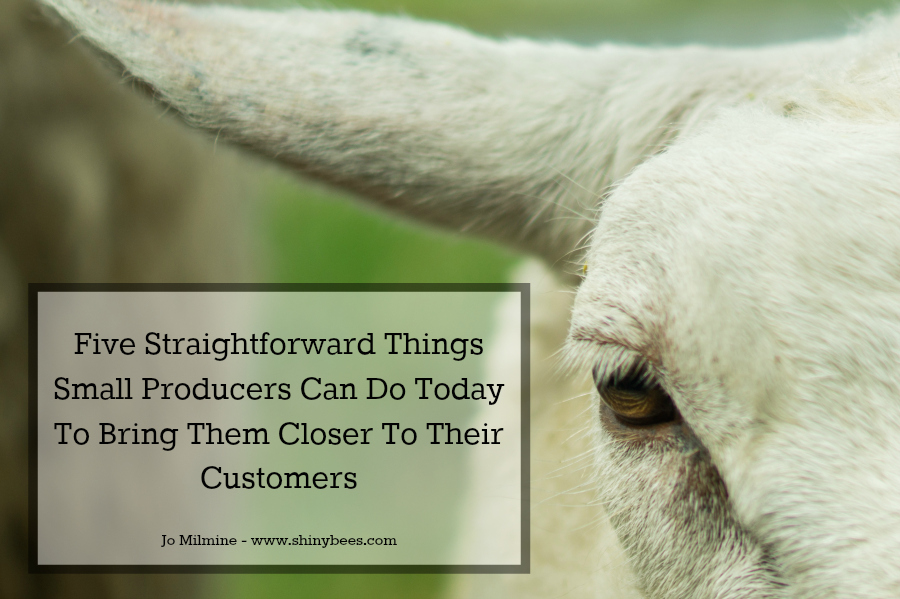We are delighted that Jo Milmine is here today with her top tips which will help close the gap between small producers and wool consumers.

Provenance is a factor that is of increasing importance for a growing number of knitters and yarn loving folk – myself included – who want to know the story of where their yarn is coming from. A growing emphasis on sourcing locally and an attitude of supporting local business presents a fantastic opportunity for small producers to share their products with an eager audience.
Recently, I attended two yarn shows in Northern Scotland. Here, I discovered some amazing single farm yarns, including an organic yarn and another that was grown in the same postcode that I lived.
I was giddy with excitement at these yarns of great integrity. They were special. Single farm. Just round the corner! How’s that for provenance and shopping local? Amazing!
I had to share these wonderful discoveries with my yarn loving fibre aficionados around the world. They would be just as excited as I was. They were keen to try these beautiful yarns for themselves. They asked where they could buy them.
There was just one problem.
None of the yarns were available to buy online. Not one. And as Northern Scottish yarn shows aren’t the easiest to get to (although totally worth the trip!) my fibre fanatic friends would be buying none of them. This made me really sad. I was sad that so many people I knew would love the yarns were missing out and I was sad that the producers were missing out on sales that they need to stay in business.
This article is a plea, in the year of focusing upon the array of wonderful, home grown, small producers, to embrace the opportunities offered by creating an online presence. We love you. We want to support you. Please help us to find you and buy from you.
So in the spirit of enabling, I’ve put together five ways that you can start to do this, for free or minimal cost, today.

Build An Email List
If you only do one thing as a small producer selling yarn (or anything else for that matter) building an email list needs to be it. With the highest return on investment of any online marketing tactic, it’s a business no-brainer if you want to increase sales and build a relationship with your customer base.
Do you need a website to do this?
No.
It can be as simple as a sign-up sheet on your stall, although there are other ways to offer email sign-up online, such as linking through a Facebook App on your business page, or installing pop-ups or banners on your website if you have one. There are a variety of online solutions for this that offer what can feel like a bewildering array of options. If you’re just starting out, I recommend Mailchimp . It’s free (to 2000 email addresses), it has an easy to use drag and drop interface and lots of tutorial support, along with decent analytics. It also has the ability to grow with the business and offers more advanced features should you need them.
The benefit of email marketing over other channels is that the people who are giving you their email address already like you enough to want to hear from you again. Think of it as swapping mobile numbers with someone; you don’t just go around giving those details to anyone. You only give it to people you like.
It’s a similar concept with email addresses. These people want to keep in touch. They want your news and offers. You’re already well on your way to establishing that ‘know, like and trust’ status and these customers want your products. Having a ready group of interested buyers is great for business!
Which brings me on to my next point.
When you have these email addresses, you actually have to email people. Yes. That’s right. I’ve joined the mailing list of a number of small indies in the hope that I’ll be the first to know of any updates and I’ll never miss the latest news or yarns and I’ve patiently waited for my email. And waited. And waited. And it still hasn’t come, to me, or anyone else on the list.
Reasons for this varies from “I don’t want to annoy people” (when have you ever been annoyed by an email from someone you like?) to “I don’t know what to say” (talk about yarn!) and everything in between. It’s time to stop being shy and getting in your own way over this. These subscribers like you and they want to hear your news and buy your goods. Talk to them.
Create A Simple Website
It is possible to create a really simple website in a few hours. You don’t need a developer and it isn’t necessary to have something super fancy in order to have a web presence.
But why do I need one?
Your website is your online home and the place most people go to find the answers to their questions is the internet. If you have no online presence, people looking for small producers will struggle to find you. If they don’t know you’re there, they can’t buy from you.
Your website allows you to tell people who you are and what you do every minute of every day and is not limited by geographical constraints or time zones. It also allows people who have found you at fairs or shows to find you again. Crucially, it gives them somewhere to send their friends, readers or listeners to when they are talking about or recommending your products.
As mentioned above, it doesn’t need to be a huge outlay in time or money to arrange a website. There are a number of online providers you can use to create your site, and I recommend starting with WordPress.com (which is different to WordPress.org). With WordPress.com, you have free hosting and can secure a top-level domain (i.e. one without the .wordpress.com URL, it would just be yourcompany.com) for $18 per year, which is about £1 per month. A good selection of themes (pre-coded designs) are free and offer scaling for different devices (mobile, desktop and tablet) already coded in.
If you want a website with e-commerce capability, you could consider the WordPress Business plan at $299 per year. At around £17 per month, I still think it’s a cost-effective way to host a store, but as we’re going cheap or free, I have another suggestion for you in the next section.
WordPress.org (often referred to as ‘self-hosted WordPress’) offers far more options for customisation but does need a little bit more outlay in terms of paying for hosting. There are many tutorials on YouTube that will walk you through building a website this way, step by step. (https://www.youtube.com/watch?v=sd0grLQ4voU)
There are other website providers (Squarespace, Wix, Weebly are a few) that can be used if preferred. I suggest WordPress due to the large numbers of free resources and how-to guides available online and because WordPress is a very established provider.
![]()
Create An Online Store
I’ve found some beautiful yarns from interesting small producers at shows – and I go to a LOT of shows all over the UK – and nothing is more frustrating than wanting more and not being able to order it online. It’s a huge missed opportunity: instead of selling to maybe four or five thousand people at a large show on one weekend, you could be selling to millions whilst you sleep. Customers don’t want to wait for the next show or enter into prolonged email discussions about what vendors do or don’t have in stock. It’s a big barrier to purchasing and a lot of people will simply go somewhere else where they can buy easily.
If a full website with e-commerce capability is too much for you right now, consider using a ready-made store online. Again, there are plenty to choose from and I think Big Cartel is a great option to try this out. It’s free for up to 5 products, has a low monthly fee if you need more ($9.99 for up to 25 products) and is specifically aimed at artists, makers and creatives.
You might also consider Etsy or Folksy (both handmade marketplaces, with the latter being more UK focused) although the fees for listing and selling can soon add up, particularly as sales grow as they take a percentage of the selling price.

Choose One Social Media Channel (And Use It)
Yes. Just one.
There’s no point having an account on every single social media platform going, as it will be impossible to keep up. One profile done properly will be far better than five or six that you don’t get chance to interact with people on. Also, choose a platform you like working with, as if it’s a chore to go on there, you’ll just avoid it – who wouldn’t?
For example, Facebook is a huge network and an obvious choice for a lot of people as they are familiar working with it. It is, however, becoming increasingly a ‘pay to play’ environment for businesses, with posts being shown to fewer people, unless you’re doing paid advertising. Facebook advertising can be cost effective and highly targeted done well (but that’s another blog post entirely).
If you like short and snappy, Twitter could be a good choice. Instagram is becoming increasingly popular amongst crafters as it’s very visual; if you like taking and looking at photos, this may work for you.
Once you’re comfortable working with one platform, you can expand and establish yourself on another one or two. When choosing these, again, think about which ones you like using and also where your customers hang out.
Remember, just being ‘on’ social media isn’t enough – you need to be talking to people and building relationships for this to be a successful way of finding customers. Blasting out post after post of, “buy my stuff” will not increase sales – it will decrease followers though! Social media works best when you use it to get to know your customers better and communicate with them.
Create a Profile and Group on Ravelry
I’ve interviewed lots of people working in the yarn industry on my podcast, and when asked “What’s the one resource for yarn craft or business that you couldn’t do without?” around 90% of them say, “Ravelry.”
This is with good reason.
Ravelry has allowed independents to compete on a much more level playing field and make their designs and products available in a place where lots of their ideal customers are. It also does this at very low cost: it’s free to join, advertising is incredibly competitively priced as are the fees for selling patterns.
It also acts as an online portfolio for businesses. Members can upload details of their projects, or even just the yarns as they buy them and all of these will be linked back to your company. They’re searchable by the 5 million plus members, many of who will be interested in your products too.
I’d recommend making a profile with a name that is easy to link to the business, to which you can add all the projects you’ve made. You can also create a group where customers can hang out and chat together in the forums section of Ravelry.
It’s also really important to list all the yarns and/or patterns on the Ravelry database. This will allow existing customers to link to them with their projects (creating the portfolio mentioned above) and also contains all the technical details such as fibre content, yardage, WPI and gauge.
Start Simply and Build Up
These suggestions for increasing visibility for your business online and enabling customers to find and buy from you are not quick fix options that will make you millions overnight. Implementing just one of these with consistency will allow you to improve the likelihood that people like me, who love single farm and small producers and want to support them, can find you and do just that.
They are designed to help those who don’t yet have any online presence take their first steps into the digital realm. Of course, there’s lots to explore and although there are many other things to be expanded into if you wanted to; this article is aimed at encouraging a small, achievable action which will bring producers and buyers closer together.
Team Wovember are very grateful to Jo for creating what should be the check-list for every small business. This year at Wovember we have shone a large spotlight on small wool producers and businesses and the work they do. Similarly, we have attempted to address the issues that consumers encounter when trying to access small producers. Without straightforward action, as Jo sets out here, small producers do run the risk of missing out on opportunities.
Just exploring social media can throw open what you do to the world wide web. Take for example Herdwick Shepherd – he has no laptop up on the fells, but through using twitter on his smart phone and capturing his work, his sheep and the landscape he has over 70K followers. Another example is Benjamin Hole, on Instagram, whose Isle of Purbeck Poll Dorset yarn sold out in record time due to regular photograph posting of the process from farm to yarn.
If you are reading this post and feel any of these areas are letting you down and are stopping you from connecting with your intended audience then consider this your call to action.
__________________________________
